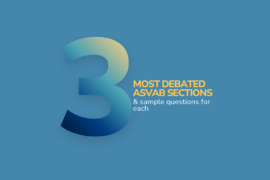You already know that taking a CLEP exam saves you time and money by helping you earn college credit. If you’re passionate about computers and are considering a degree in Computer Information Systems or Computer Science, taking the CLEP Information Systems exam is a good choice for you.
What’s on the exam?
The CLEP Information Systems exam covers the fundamentals of an introductory college-level business information systems course. Exam materials assess your knowledge and familiarity with terminology, basic concepts about information systems, and how to apply that knowledge. The exam focuses on concepts and techniques applicable to a variety of products and environments.
You will have 90 minutes to answer approximately 100 questions, although some of these are pretest questions that will not be scored.
Knowledge and skills required
Test-takers will be asked questions and need to demonstrate their knowledge of the following content (percentages next to each topic emphasize the weight of that topic on the exam):
Office Applications (10%)
- Productivity software (word processing, spreadsheet, presentation package, database package)
- Operating systems (memory management, file management, interfaces, types of OS)
- Office systems (email, conferencing, collaborative work, document imaging, system resources)
Internet and World Wide Web (15%)
- Internet and other online services and methods (World Wide Web, protocol, Web search engines, Web bots, intranet, cloud computing, communications, push/pull technology, W3C)
- Web browsers (URLs, protocols, standards, history, cookies, resource allocation)
- Web technologies (HTML, XML, Javascript)
- Website development (analysis, design, functionality, accessibility)
Technology Applications (15%)
- Specialized systems (knowledge management, expert systems, TPS/OLTP, DSS, GIS, BI, workflow management, project management)
- E-commerce/E-business (EDI, standards, tools, characteristics, types of transactions, business models)
- Enterprise-wide systems (ERP, CRM, SCM)
- Data management (data warehousing, data mining, networking, security, validation, migration, storage, obsolescence)
- Business strategies (competition, process reengineering, process modeling, TQM, Web 2.0)
- Information processing methods (batch, real-time, transaction)
Hardware and Systems Technology (15%)
- Devices (processing, storage, input and output, telecommunications, networking)
- Functions (computer, telecommunications, network hardware)
- Network architectures (local area, wide area, VPN, enterprise)
- Computer architectures (mainframe, client/server, operating systems)
- Wireless technologies (Wi-Fi, cellular, satellite, mobile, GPS, RFID)
Software Development (10%)
- Methodologies (prototyping, SDLC, RAD, CASE, JAD, Agile)
- Processes (feasibility, systems analysis, systems design, end-user development, project management)
- Implementation (testing, training, data conversion, system conversion, system maintenance, post-implementation activities, post-implementation review, documentation)
- Standards (proprietary, open source)
Programming Concepts and Data Management (10%)
- Programming logic (Boolean, arithmetic, SQL)
- Methodologies (object-oriented, structured)
- Data (concepts, types, structures, digital representation of data)
- File (types, structures)
- Database management systems (relational, hierarchical, network, management strategies)
Social and Ethical Implications and Issues (25%)
- Economic effects (secure transactions, viruses, malware, cost of security)
- Privacy concerns (individual, business, identity theft)
- Property rights (intellectual, legal, ownership of materials, open-source software)
- Effects of information technology on jobs (ergonomics, virtual teams, telecommuting, job design)
- Technology’s influence on workforce strategies (globalization, virtual teams, telecommuting, outsourcing, insourcing)
- Careers in IS (responsibilities, occupations, career path, certification)
- Computer security and controls (system, application, personal computer, disaster recovery)
- Social networking (benefits, risks, ethics, technology, Web 2.0)
RELATED: Getting a Computer Information Systems Degree
Sample Test Questions
To test your skills, answer the following sample questions. Scroll down for the answers.
1. A(n) _____ is a type of communications device that connects a communications channel, such as a cable television line or a telephone line, to a sending or receiving device such as a computer.
A. Server
B. PDA
C. Modem
D. ATM
E. All of the above
2. In a communications system, data and information travel over a communications channel. For best performance, a communications channel’s _____.
A. Bandwidth and latency should be low
B. Bandwidth should be low and latency high
C. Bandwidth and latency should be the same
D. Bandwidth should be high and latency low
E. Bandwidth and latency should be high
3. A bit (binary digit) is the smallest unit of data a computer can process. When 8 bits are grouped together as a unit, they form a _____, which can represent 256 individual characters.
A. Chip
B. Byte
C. Code
D. Field
E. Record
Preparing for the Exam
Peterson’s helps you prepare for the CLEP Information Systems exam with practice tests that cover the material and concepts presented on the CLEP exam and tips for studying for standardized tests. Subscribe to Peterson’s test prep and take your exam(s) with confidence!
Answers for Sample Questions
- The correct answer is C. A modem transfers signals between a computer and a communications channel. If the communications channel uses analog signals, such as a telephone line, a modem converts between the analog signals and a computer’s digital signals.
- The correct answer is D. Bandwidth is the amount of data that can travel over a channel, and latency is the time it takes a signal to travel. For best performance, the bandwidth (amount of data) should be high, and latency (time it takes) should be low.
- The correct answer is B. A byte provides enough different combinations of bits (0s and 1s) to represent numbers, uppercase and lowercase letters, punctuation marks, and other characters.



